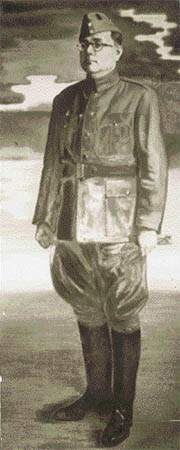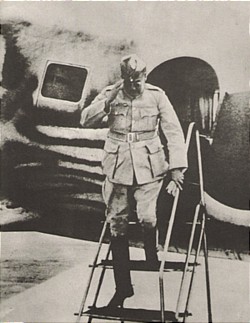
Netaji: The mystery deepens
What happened to Subhas Chandra Bose in 1945?
Maj Gen Himmat Singh Gill (retd) says many questions remain unanswered if we buy the story that he died in the plane crash at Taipei
 An
organisation called Mission Netaji,
invoking the RTI Act, has succeeded in forcing the government to make
public the secret and controversial documents relating to Netaji
Subhas Chandra Bose’s reported death in a plane crash at Taipei on
August 18, 1945. This would be welcomed by every nationalist Indian,
for many of whom Netaji was as towering an icon as Mahatma Gandhi.
Questions which have remained unanswered to date and troubled this
writer are: whether there was such a plane crash and was Netaji on
board? Did he die in the crash as announced by the Japanese.
An
organisation called Mission Netaji,
invoking the RTI Act, has succeeded in forcing the government to make
public the secret and controversial documents relating to Netaji
Subhas Chandra Bose’s reported death in a plane crash at Taipei on
August 18, 1945. This would be welcomed by every nationalist Indian,
for many of whom Netaji was as towering an icon as Mahatma Gandhi.
Questions which have remained unanswered to date and troubled this
writer are: whether there was such a plane crash and was Netaji on
board? Did he die in the crash as announced by the Japanese.
What is known is that
Netaji had first journeyed to Moscow en route Germany, and from there
after a prolonged stay he had been transported to Tokyo by sea in
German and Japanese submarines in May 1943, to take over the reins of
the INA, which was then waging a war against the Allied Forces
operating in the Far-Eastern Theatre. The Great Escape to Germany from
Calcutta via the Khyber Pass, Kabul and Moscow in 1941, and later in
1945 when as believed by many Netaji took the final flight out of
Saigon to Manchuria from where he is understood to have crossed over
into the Soviet Union and obscurity, will continue to be studied by
political analysts and historians alike who have never bought the
official finding that Netaji perished in the Taipei air crash. Though
the Shah Nawaz Khan Committee set up during Jawaharlal Nehru’s time
and, later on, the Justice G.D.Khosla Commission in 1970 had both
ruled that Netaji had died in the Taipei crash, the Justice
M.K.Mukherjee Commission in its 2005 report has totally debunked this
conclusion of Netaji’s purported death. Inquiries made in Saigon and
later in Kabul in our embassies and with many of the old-timers in
both the places, have revealed that no one had ever heard anything
about the plane crash at Taipei. Though the 1941 Kabul-Moscow journey
was a well-recognised fact, there were no signs of any kind that
indicated a return journey by Netaji in 1945 through present-day
Kyrgtistan, Tajikstan ( both then part of USSR and the shortest route
home) or Moscow for that matter into Afghanistan presumably en route
India, after his reported crossing over into Russian territory from
Dairen. Where did Netaji suddenly vanish after his entry into Russia
in 1945? This is a question that needs to be answered.
To understand what
possibly happened to Bose on his last flight to Dairen in Manchuria,
it is necessary to retrace his successful outward journey through
Afghanistan in 1941. As Pradip Bose records in his book Subhas Bose
and India Today, Netaji braved a trek over the Khyber Pass and
across the Kabul river gorge and the icy Sairobi plains in an
overcrowded bus and made his way to Kabul on January 27, 1941. It
could have only been a person with a tough mind like that of Netaji
who could have made such a hazardous and dangerous journey in such
inclement weather and on a highway where even during daytime there are
good chances of being waylaid and looted.
Sadly, when Netaji
arrived in Kabul he found that the Russian Ambassador there was not
very keen on giving him a visa to travel to Moscow, since they
anticipated that if Germany attacked Russia as was expected then the
Russians would become the allies of the British and it would not do to
be seen to be assisting an enemy of the Empire.
When Japan attacked
Pearl Harbour, Bose decided to travel to Japan in 1943 to influence
the operations on the Burma-India border with the assistance of his
new hosts.
By mid-August 1945, when
Japan was on the run, Netaji found himself at Singapore heading a
bedraggled INA most of which had already been taken into detention by
the Allied Forces and who were now being held in concentration camps
awaiting deportation and trial after the war ended. Netaji’s initial
plan to stick on with the INA in Malaya and Singapore underwent a
change at this stage and he made plans to move closer to the
neighbourhood in Burma to carry on the freedom struggle for India. By
then the Burmese army had switched its loyalties to the winning Allied
Command. It was not possible to set up INA resistance bases in the
region, and neither was a route through Burma found practical for
Netaji’s return to India because of lack of any local assistance so
crucial in such operations.
With the maritime routes
blocked by the Allies and the confidence gained in having made a
similar land journey before through South and Central Asia, the only
feasible routing for Netaji from Singapore was therefore through
Saigon, Taiwan, Manchuria and thence into Russia, for a return via
Kabul to India. After the nuclear bombing of Japan, it has been well
documented that the Russians had launched deliberate attacks from
Russian Manchuria into Japanese controlled territory southwards
towards Harbin, Fushun and Dalian, and therefore Netaji making for
Darien and thence into Russian territory made perfect sense.
The intriguing part,
however, is that Netaji is supposed to have died when his plane was
taking off from Taipei, and therefore it is clear that there had to be
a destination for which he was heading. Surely he could not have been
heading for Japan which was by then tottering to a meek fall,and
neither could his bomber aircraft with the flying range that such
aircraft had in those days be heading right across the vast Pacific
Ocean to Hawai and American territory!
Anuj Dhar of Mission
Netaji had been intimated by the Taiwanese government in 2003 that no
plane carrying Netaji had ever crashed in their territory. Neither is
it possible that having flown all the way from Saigon, Taipei was
Netaji’s final destination and not just a stopover for refuelling of
the aircraft. What was Netaji going to do in the middle of nowhere in
Taiwan, when all around him the Axis Powers were collapsing one after
the other? It is logical to believe that Netaji took off from Taipei
safely and flew on to Dairen, irrespective of Col Habib-ur-Rehman’s
(his fellow passenger on the flight) report in the matter much after
the purported crash. It is also intriguing that whereas Netaji died of
severe burns in the purported crash, Habib-ur-Rahman only had some
burnt skin and scars to show for the good luck in his survival.
There is a linkage in
this to what Shyam Lal Jain of Meerut, deposing before the Khosla
Commission (an account documented by Pradip Bose in his book referred
to earlier), had stated that he was asked by Nehru in Delhi to type
out a handwritten note which he (Nehru) had handed over to him, and
the contents of which Jain, reproducing from memory, had stated to the
Commission as follows, "Netaji Subhas Chandra Bose proceeding by
aeroplane from Saigon, arrived today August 23, 1945, at Dairen
(Manchuria) at 1.30 afternoon". Shyam Lal, in his recorded
statement, goes on to state that according to the said note, after a
short break Netaji and four others left in a jeep for Russian
territory. Access to classified documents of the period will throw
light on Bose’s flight in 1945, and there is need to delve further
into the matter in the interest of recording truthful history. An
unconfirmed report had also appeared earlier that Netaji had died at a
ripe age in a Siberian prison, and Pradip Bose also mentions in his
book that in July 1946 there were reports that Khurshedben Naoroji, a
Secretary of Mahatma Gandhi, wrote to American author Louis Fischer
that if Netaji came back to India with the support of the Russians
then neither Gandhi nor the Congress would be able to do anything
about it. Who then or which power in India was interested in seeing
the last of Netaji and did not want his return to his homeland? Was
the story of the Taipei crash deliberate misinformation first put out
by Japan and later on confirmed by Indian high-ups, so that Netaji
never returned to India.
Americk Singh Gill, a
former INA man in his book Indian National Army—Secret Service
also writes that, "I was thinking that Netaji had put up a mighty
camouflage and curtain with the story of the aircrash",
indicating that many of those who had been close to Netaji had found
it difficult to suddenly believe that he had died in the air crash at
Taipei.
There is certainly more
than what meets the eye in the sudden disappearance of Netaji in
mid-1945, and if the Americans are still investigating the
assassination of President John Kennedy then there is no reason why
the Indian people, if not their government, cannot move international
agencies and the present governments of Russia, Japan, UK, Vietnam,
China, Mangolia, Afghanistan and America to release from their
archives any confidential material for scrutiny which could reveal the
final years of this great patriot.
The Shah Nawaz and
Khosla Commissions did to my mind an incomplete and rushed job by just
buying the Taipei air crash theory. We often entrust such enquiries to
politicians and members of the judiciary. Many of them have little
idea of the peculiar terrain, topography and distances of the Far
East, all inter-related factors in Netaji’s journeys to that part of
the world and his sudden disappearance. It is time for a full-fledged
Commission with the right people on it, to find out how and when
Netaji met his end.

The last picture of Bose on August 18, 1945
m
No comments:
Post a Comment